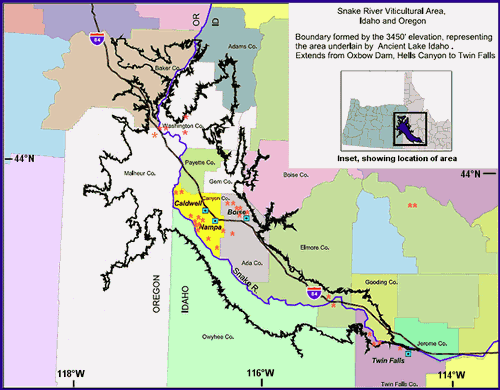Snake River Valley AVA
A sure sign of Idaho's maturing wine and vineyard industry was the collaboration of wineries, viticulturists, USDA and academia in the Snake River Valley that led to the development and 2005 submission of an application to the US Department of the Treasury's Alcohol and Tobacco Tax and Trade Bureau (TTB) requesting consideration and authorization as an American Viticultural Area (AVA). The application process was a laborious one, requiring detailed information about the geographic boundaries for the proposed appellation, its geological character, its history related to grape and wine production, and why the area is distinct from others. The documented success of wine growing throughout the Snake River Valley region ultimately proved the case, and the Snake River Valley AVA / appellation was authorized in 2007; its boundaries include parts of eastern Oregon.
The Snake River Valley appellation includes the area known as prehistoric Lake Idaho, which existed in southwestern Idaho about 3.5 million years ago. It stretched from today's Brownlee Reservoir in Hells Canyon to an area that ends just before Twin Falls. This area includes the majority of Idaho's wineries and vineyards, most of which are located in southwestern Idaho's Sunny Slope region near Marsing.
Snake River Viticultural Region and Eastern Washington
... differences and commonalities
Despite the variability of their respective terroir, the Snake River Valley region of Idaho and Eastern Oregon are strikingly similar to that of Eastern Washington:
Both regions' geological histories are influenced by volcanism and glaciations;
Both experience hard winters on a somewhat regular cycle -- although both are experiencing a change in these historic cycles perhaps related to the overall effects of global warming;
Both laid the foundation of their industries on white wines, particularly Riesling;
Both are located in dry agricultural areas that receive fewer than 10 inches of rain a year, facilitating vineyard canopy management by irrigation.
The primary differences between these two regions involve vineyard elevations and differing soil types brought about by variations in their geologic stories.
